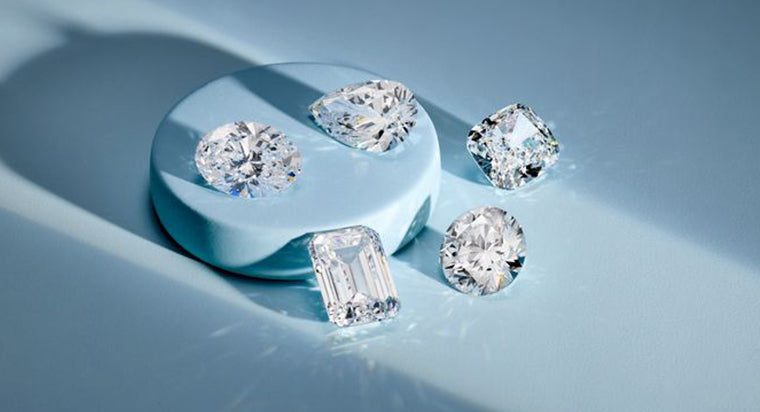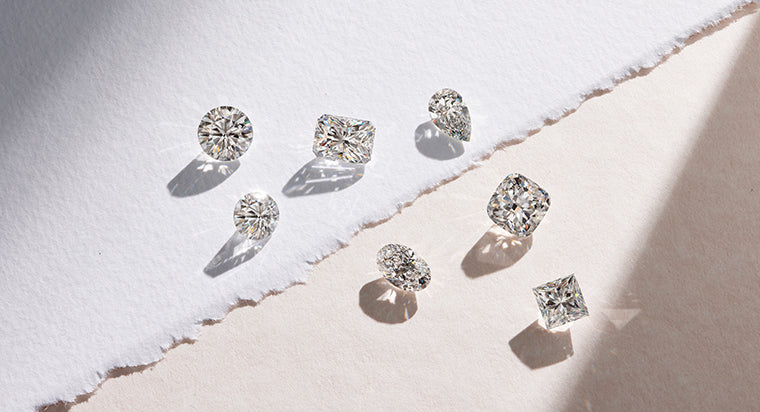Diamond Inclusions: What They Are, Types, Which to Avoid

Clarity is one thing you'll hear a lot about (especially from expert gemologists) when researching and shopping for a diamond engagement ring. But most of us don't give a second thought to how clear our diamonds are — aren't they all the same anyway?
Not exactly. Diamond clarity is one of the all-important 4 Cs of diamonds, along with carat weight, color and cut. Most of us only worry about diamond carats and cuts, but there's a hidden way to save money on diamonds that you probably don't know about and it all comes down to the amount of clarity in the stone you pick. Let's break down the main factor that influences diamond clarity — what they are and how they can affect the quality and price of your engagement ring.
TABLE OF CONTENTS
What are Diamond Inclusions?
Simply put, inclusions are the flaws in the diamonds you buy.
Diamonds might be spiffed up when you buy them, but diamonds look pretty rough when they're pulled from the mines. While some of these diamonds end up looking pretty flawless when they're cut, the majority of them end up with inclusions — some you can see, some you can't. Nearly every diamond has some sort of inclusions in it. While there are diamonds without inclusions, they're so rare that even most diamond experts haven't seen one.
The fewer number of inclusions a diamond has, the more it'll cost; but the opposite happens when the number of inclusions goes up. While inclusions are flaws, most of them can't be seen with the naked eye, but can save you considerable cash when it's time to buy. There are even some inclusions that gemologists struggle to see under magnification.
What Types of Diamond Inclusions are There?

Pinpoint
There are over a dozen types of inclusions commonly found in diamonds. The most common of the diamond inclusions is a pinpoint. These are exactly like they sound: tiny black dots that are noticeable on the table of a diamond.

Feather
Feathers are the second-most common inclusions, and are tiny cracks that span the diamond from top to bottom and, if deep enough, can compromise the structure of the diamond.

Crystal
Think of a crystal as kind of a diamond within a diamond. It's typically comprised of tiny bits of diamond or mineral deposits that were trapped within the diamond as it formed.

Needle
A needle inclusion is a type of crystal that resembles a long, thin line. It's usually white or clear.

Cloud
Cloud inclusions get their name because it resembles a cloud, but it's actually a cluster of pinpoints within the diamond.

Natural
Usually found around the four corners of a diamond's girdle, a natural inclusion is a part of the original diamond that stayed when the diamond was cut. Some diamond cutters used to leave on naturals to prove to jewelers that they didn't take too much of the diamond off during the process.

Indented Natural
An indented natural inclusion can resemble a chip, but it's actually located inside the surface of the diamond.

Knot
A knot is simply a crystal inclusion that reaches to the surface of a diamond.

Chip
A chip is exactly what it sounds like: a small notch taken out of the surface of a diamond. Unlike other diamond inclusions, chips are typically a result of wear and tear. The good news: They can typically be removed with polishing or re-cutting.

Cavity
A diamond cavity is much like that of a tooth cavity: a small hole in the surface of a diamond. It's not a good idea to buy a diamond with a cavity — and most jewelers won't even sell them to you. Instead, diamonds with cavity inclusions are used for “industrial” purposes. (What does that mean, you might be wondering. Diamonds can only be cut with diamonds. So some diamond material has to be used to edge the machines used in diamond cutting for it to even be possible.)

Twinning Wisp
Typically only found in fancy shape diamonds, a twinning wisp is believed to be a growth defect of a diamond comprised of crystals, clouds, feathers and pinpoints.

Internal Graining
This type of diamond inclusion happens when crystals in the diamond grow unevenly, creating waves or lines within the diamond.

Surface Graining
While the word surface makes you think this would be a type of graining on the surface of a diamond, this type of inclusions can be internal — but near the surface — of the diamond, too.

Etch Channel
While these inclusions look like they could be man made, they’re actually a natural creation of channels from intense heat during the formation process.
How do Diamond Inclusions Affect the Price of Your Stone?
When it comes to clarity, diamonds are separated on a scale based on its inclusions. The diamonds with the fewest inclusions are called Flawless (FL) diamonds and Internally Flawless (IF) diamonds, while gemstones with inclusions visible to the eye are rated as Included (I). Most diamonds fall somewhere in the middle classes in the scale: Very, Very Slightly Included, Very Slightly Included, and Slightly Included.
As we mentioned before, flawless diamonds will be the most expensive because they're so rare. But here's the good news: You can save a considerable amount on a diamond that still looks flawless to the naked eye.
Because clarity grades are subjective, you can save anywhere from 15% to 25% on each clarity scale you go “down.” So if you go for a Very, Very Slightly Included diamond instead of an Internally Flawless, you’ll save big. The same goes if you go from a Very, Very Slightly Included diamond to a Very Slightly Included diamond — and from a Very Slightly Included diamond to an Slightly Included diamond. (You get it.)
How do Inclusions Influence the Look of Your Diamond?

Included diamonds will tend to have more haziness, loss of sparkle or other distracting elements that can take away from the look of the stone.
Are Inclusions Ever a Good Thing?
Yes! Some inclusions are small enough that they bring down the price of the stone without changing the appearance of the stone to the naked eye. In other words: You can likely get a diamond with a higher carat weight, color or more expensive cut because you're saving on the clarity part of the 4 Cs.
Understanding diamond inclusions can be confusing, but you don't have to navigate it alone. At With Clarity, we have expert gemologists on staff who can explain everything you need to know about inclusions in detail — and help you find the right stone to maximize your budget.
Lab Diamond vs Natural Diamond Inclusions?

When is comes to diamonds, both lab grown and natural diamonds have the same types of inclusions. Lab grown diamonds can also have inclusions form as they are grown in a lab that mimics the conditions of the earth. Because of this, the diamonds themselves can be of various colors, clarities and have inclusions that are large and small.
As labs are getting more proficient, inclusions can be minimized and smaller, however just like in natural diamonds, there will always be a range of qualities. Natural diamonds have the same common inclusions as lab created diamonds.
Fissures, surface graining, cavities, crystals and knots are just some of the inclusions that can form within a natural diamond as it forms under heat and pressure deep within the earth. The key is always to find the right balance of inclusions so that you're within your budget and the quality range that you are looking for.
Inclusions on a Diamond Certificate
Inclusions are always described for larger diamond carat sizes on the certificate. There is a written description of the types of inclusions. Generally, a few smaller inclusions are not going to materially change the look of the diamond. However, a few large inclusions or maybe even one large one will really detract from the look of the diamond.
Ensure that you're reviewing the diamond plot along with the clarity grade of the diamond to get something at or above "eye clean." In an eye clean diamond, you will not see any inclusions with the naked eye. Both IGI and GIA certificates will assign grades based on he same inclusion types and present information in the same way on a certificate.
FAQs
What are inclusions in diamonds?
Do lab diamonds have inclusions?
Do all diamonds have inclusions?
What is the best clarity for a diamond?









